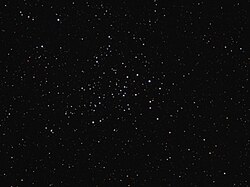Loading AI tools
Open cluster in the constellation Perseus From Wikipedia, the free encyclopedia
NGC 1528 is an open cluster in the constellation Perseus. It was discovered by William Herschel in 1790. It is located in the north-eastern part of the constellation, just under 3 degrees north of μ Persei. Less than 1.5° to the southeast is the open cluster NGC 1545 (m = 6.2). The NGC 1528 is clearly visible with 10x50 binoculars. 165 stars are recognised as members of NGC 1528, the brightest of which has apparent magnitude 8.7.[4]
| NGC 1528 | |
|---|---|
 NGC 1528 Open Cluster | |
| Observation data (J2000 epoch) | |
| Right ascension | 04h 15m 30.72s[1] |
| Declination | +51° 13′ 04.8″[1] |
| Distance | 3,110 ± 500 ly (954 ± 154 pc)[2] |
| Apparent magnitude (V) | 6.4[3] |
| Apparent dimensions (V) | 23' |
| Physical characteristics | |
| Estimated age | 110 Ma[2] |
| Other designations | Cr 47 |
| Associations | |
| Constellation | Perseus |
Seamless Wikipedia browsing. On steroids.
Every time you click a link to Wikipedia, Wiktionary or Wikiquote in your browser's search results, it will show the modern Wikiwand interface.
Wikiwand extension is a five stars, simple, with minimum permission required to keep your browsing private, safe and transparent.